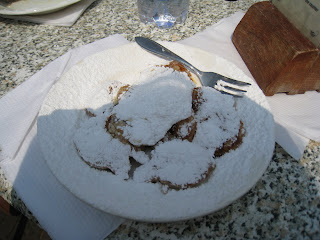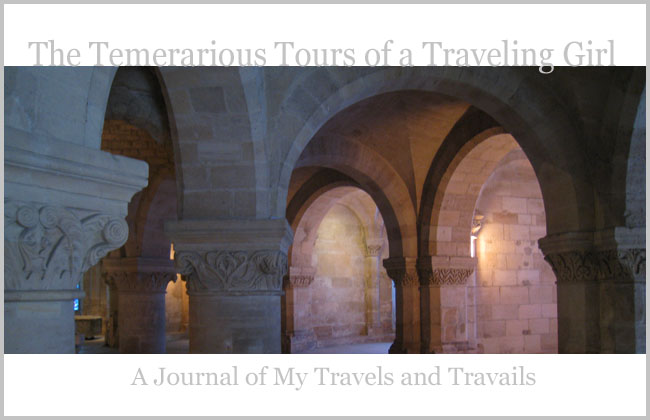
The Grote Kerk St. Bavo
The heyday of Dutch Golden Age painting began in Haarlem before Amsterdam rose to prominence as the cultural capital of the seventeenth century Netherlands. 

Beautiful frescoed ceiling over the crossing.
I am in love with old churches and could have spent hours in the Grote Kerk which was especially interesting because it had the late medieval rood screen still intact. 584 569 Rood screens were used in almost all churches before the Protestant Reformation to shield the altar from the laity and usually ran from one side of the nave to the other before the crossing of the transept (that’s why the pulpits in old churches seem to be oddly located in the middle of the nave today).
 Rood screens were actually the Western version of the iconostasis used in the Byzantine churches in the Eastern Roman Empire and were usually decorated with paintings. The one in the Grote Kerk is actually made from brass, so the altar is obscured but visible, which I don’t think is that odd for Northern churches.
Rood screens were actually the Western version of the iconostasis used in the Byzantine churches in the Eastern Roman Empire and were usually decorated with paintings. The one in the Grote Kerk is actually made from brass, so the altar is obscured but visible, which I don’t think is that odd for Northern churches.
 Rood screens were actually the Western version of the iconostasis used in the Byzantine churches in the Eastern Roman Empire and were usually decorated with paintings. The one in the Grote Kerk is actually made from brass, so the altar is obscured but visible, which I don’t think is that odd for Northern churches.
Rood screens were actually the Western version of the iconostasis used in the Byzantine churches in the Eastern Roman Empire and were usually decorated with paintings. The one in the Grote Kerk is actually made from brass, so the altar is obscured but visible, which I don’t think is that odd for Northern churches. 
The early sixteenth-century rood screen.
However, it’s extremely rare to see an intact rood screen, even in the Catholic areas of Europe and even more so in a staunchly Protestant area, but I found it extremely interesting because it clarified for me how most churches would have looked in the late Middle Ages.
After exploring the Grote Kerk, we headed over to the Frans Hals museum which houses a fairly large and high quality collection of primary seventeenth century Dutch paintings.
After exploring the Grote Kerk, we headed over to the Frans Hals museum which houses a fairly large and high quality collection of primary seventeenth century Dutch paintings.
 One gallery held five early Flemish and Netherlandish paintings, so of course I spent a very significant amount of time there! The museum also had two altarpieces on display which were fabulous to see because they put into perspective the scale on which artists painted major religious works. Each altarpiece stood at least eight feet tall and would have sat on the back of the high altar of a church. At that height, they probably would have been visible over the rood screen. With the advent of the Franciscans in the first quarter of the thirteenth century, the Church found itself losing worshippers, so in an attempt to salvage the situation, the pope and cardinals of the Church decided at the Fourth Lateran Council to change the liturgy of the mass. Instead of standing behind the altar to perform Communion, priests were told to stand in front of the altar with their backs turned to the congregation. Since the mass was said in Latin, which most people couldn’t understand, the words said over the bread and wine seemed almost like an incantation, and when the loaf and chalice were raised up, the impact would have been greater. This effect was enhanced with altarpieces which provided a background for the bread and wine as they were held up. In the center panel of one of the altarpieces at the Frans Hals museum, the artist depicted the Massacre of the Innocents, a horrible subject, but really interesting to look at in order to get a feel for an artist’s style. This particular depiction was very graphic, but had the intended effect of moving the viewer. Since the artist completely the work very shortly after the Spanish massacre of Haarlem during the Eighty Years’ War, it’s pretty likely that the altarpiece scene was influenced by an actual event.
One gallery held five early Flemish and Netherlandish paintings, so of course I spent a very significant amount of time there! The museum also had two altarpieces on display which were fabulous to see because they put into perspective the scale on which artists painted major religious works. Each altarpiece stood at least eight feet tall and would have sat on the back of the high altar of a church. At that height, they probably would have been visible over the rood screen. With the advent of the Franciscans in the first quarter of the thirteenth century, the Church found itself losing worshippers, so in an attempt to salvage the situation, the pope and cardinals of the Church decided at the Fourth Lateran Council to change the liturgy of the mass. Instead of standing behind the altar to perform Communion, priests were told to stand in front of the altar with their backs turned to the congregation. Since the mass was said in Latin, which most people couldn’t understand, the words said over the bread and wine seemed almost like an incantation, and when the loaf and chalice were raised up, the impact would have been greater. This effect was enhanced with altarpieces which provided a background for the bread and wine as they were held up. In the center panel of one of the altarpieces at the Frans Hals museum, the artist depicted the Massacre of the Innocents, a horrible subject, but really interesting to look at in order to get a feel for an artist’s style. This particular depiction was very graphic, but had the intended effect of moving the viewer. Since the artist completely the work very shortly after the Spanish massacre of Haarlem during the Eighty Years’ War, it’s pretty likely that the altarpiece scene was influenced by an actual event.After leaving the Frans Hals museum, we headed back to the main square in Haarlem, on which the Grote Kerk, as well as some of the governmental buildings are located. In front of the church was a poffertje stand selling delicious Dutch poffertje, which are similar to small pancakes, but not flat across.

Poffertjes!
It’s a very good thing that we can’t get them in the US, because I’d weigh about 500 pounds! They’re absolutely delicious, especially topped with butter and powdered sugar. We spent the remaining hour or so eating poffertje, people watching, and taking pictures.

The town square in Haarlem.
So far we’ve had wonderful weather - sunny and fairly warm, and yesterday was no exception.

The town square and the Grote Kerk.
In the afternoon we left Haarlem for Delft where we’re staying for two nights before heading on to Maastricht in the south of the country.

No comments:
Post a Comment